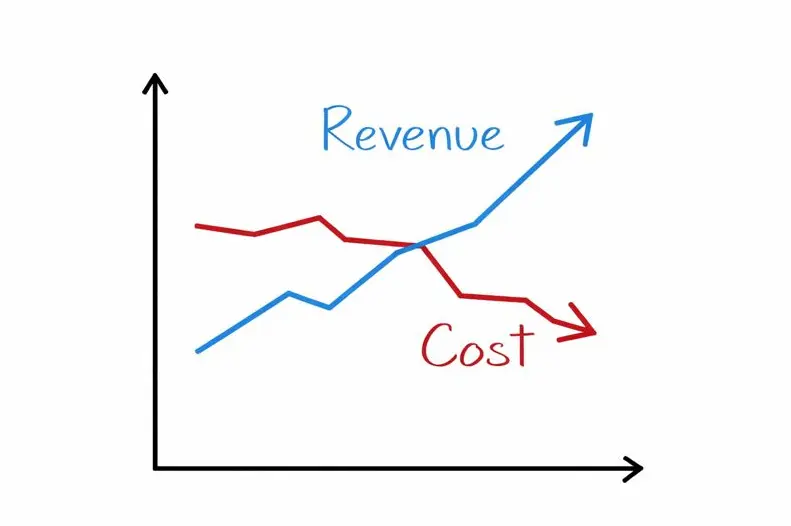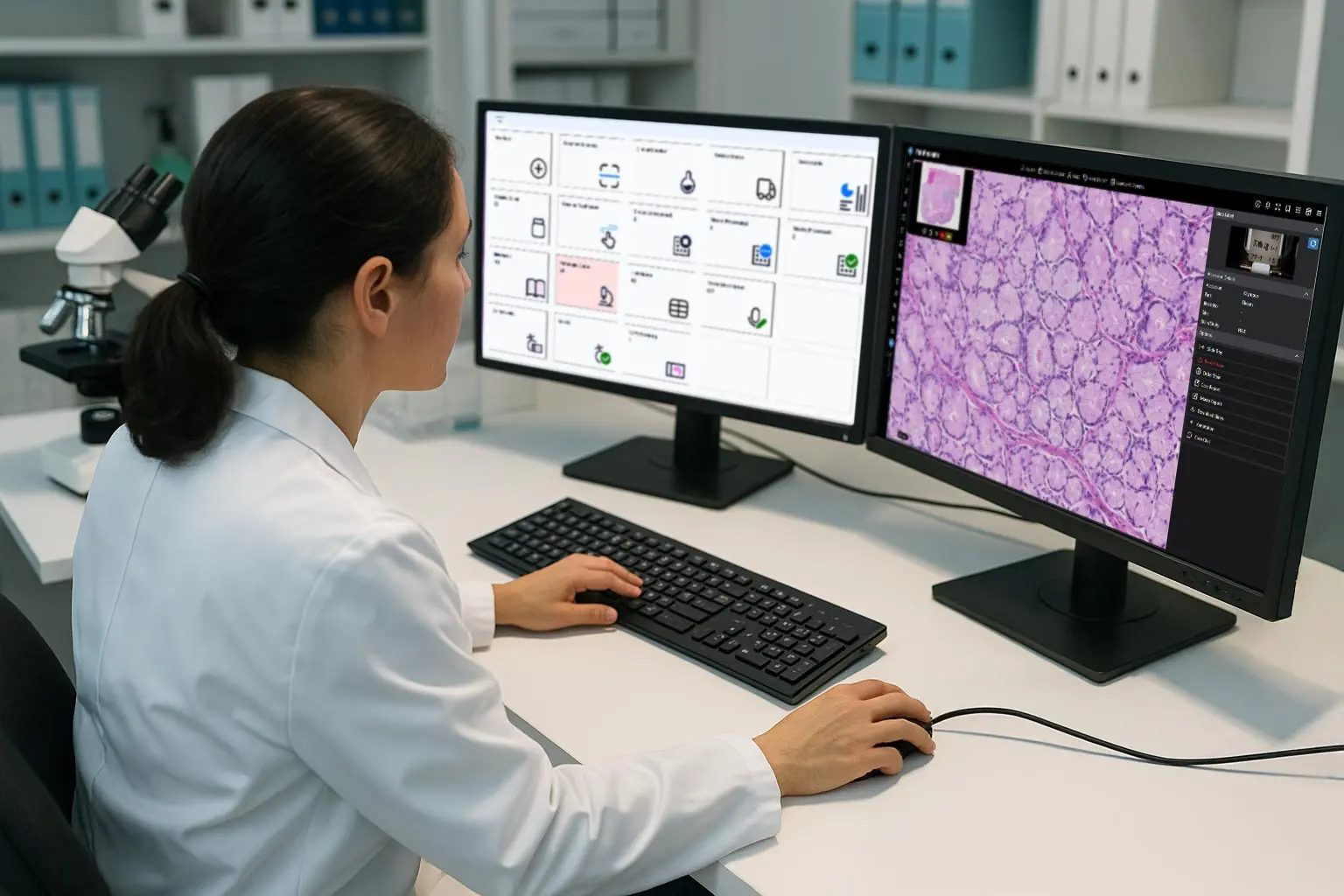Blog
Digital Pathology: The Future is Here
October 30, 2025
We’re living in a world of rapid digital transformation, where innovations like quantum internet, qubits, AI, autonomous vehicles, Web3, and the metaverse are evolving at breakneck speed, and even the most tech-savvy struggle to keep pace. Yet, despite these advances, integrating digital pathology solutions into routine clinical diagnosis remains a slow and often resisted process.
Although digital pathology was developed decades ago, it wasn’t until April 2017 that the U.S. Food and Drug Administration (FDA) permitted the marketing of the first whole-slide imaging (WSI) system, the Philips IntelliSite Pathology Solution (PIPS).
PIPS was revolutionary because it was an automated digital slide creation, viewing, and management system that enabled pathologists to review and interpret digital images of surgical pathology slides. These slides were prepared from formalin-fixed paraffin-embedded (FFPE) tissue.
The introduction of PIPS gave pathologists a digital alternative to traditional light microscopy, enabling them to view tissue samples without relying on glass slides. While this marked significant progress for the field, the evolution of digital pathology workflow has lagged behind the broader technological advancements seen across other areas of healthcare.
“Unique circumstances are stunting the growth of digital pathology,” said Tony Oganesian, LigoLab’s Chief Technology Officer. “This includes a combination of overregulation, tight reimbursement, and a lack of investment within the healthcare system. However, pathology's dwindling workforce and increasing caseloads have made complete digitization inevitable.”
Case Study: Pathology Lab Management 2025 Guide - The Future of Digital Pathology

How the Pandemic Opened the Door for Digital Pathology Solutions
Over the years, U.S. pathologists pondered what it might take for digital pathology to become the industry standard. Many small steps were made, but real momentum was always on the distant horizon. That was until the COVID-19 pandemic arrived in 2020.
“At first, when the pandemic hit and stay-at-home orders were enacted, it seemed that pathology would suffer from a slowdown,” said Oganesian. “As hospitals closed their doors and non-essential medical treatments were halted, pathologists began to worry. However, the FDA loosened its grip and began issuing waivers and emergency use authorizations for advances that had been stuck in the review pipeline. From that, digital pathology experienced an innovation boom.”
An example of this notion is when the FDA loosened restrictions on work-from-home arrangements for pathologists. In April 2020, the FDA granted a waiver allowing the use of readily available consumer monitors at home, specifically with the Philips digital pathology workflow.
Pathologists who had been unable to work on-site, due to the pandemic, were now allowed to review anatomic pathological cases from home. The benefits of digital pathology played a huge role in helping them prevent delays in critical patient care.
Learn More: The Ultimate Guide to Choosing the Best Pathology Software for Your Lab
Less Digital Pathology Regulation Equals More Innovation
This marked a major milestone for digital pathology solutions in the U.S. At its core, digital pathology was designed to enable remote collaboration, allowing pathologists to share and review high-resolution images across laboratories.
Before the pandemic, the U.S. was decades behind other developed countries in adopting digital pathology solutions and realizing the benefits of digital pathology.
Strict regulations from the FDA and CLIA, under the oversight of CMS, initially slowed progress in digital pathology. However, the pandemic prompted the FDA to ease certain requirements, accelerating the approval of digital pathology technologies to address urgent clinical needs.
Similarly, CMS temporarily waived restrictive CLIA regulations, enabling pathologists to work remotely using digital platforms. This shift not only expanded the use of digital pathology for remote diagnosis but also accelerated its acceptance and regulatory approval for clinical use.
“Now that our healthcare system has experienced the benefits of digital pathology and rapid innovation, there is hope that some of the legacy roadblocks that slowed progress will continue to be a thing of the past,” said LigoLab CEO Suren Avunjian. “Technologies that enable pathologists to work more efficiently and effectively will ultimately lead to better patient care and reduce healthcare costs.”
Case Study: OnePath - Transforming Pathology Lab Management Through Digital Innovation
Digital Pathology Solutions and the Role of Laboratory Information Systems
LigoLab’s LIS laboratory information system software provides an end-to-end pathology lab management solution for anatomic pathology labs of all sizes. Known as the LigoLab Medical LIS & Lab RCM Laboratory Informatics Platform, this pathology software supports all whole slide imaging systems, and that’s been the case for well over a decade.
“An ideal digital pathology ecosystem is one where all of a lab’s systems are interoperable, connecting as an integrated digital lab workflow,” said Oganesian. “For example, the LigoLab platform, specifically the platform’s interface engine, is interoperable with every laboratory software system a lab works with, including all digital pathology solutions.”
LigoLab provides a foundation for the digital pathology ecosystem, which consists of three major components: the laboratory information system (LIS software), the digital pathology system, and the digital pathology system tools. Digging even deeper, the primary components of a digital pathology system include the whole-slide scanner, the whole-slide image viewer, and the display monitor.
So, how do all of these pieces work together?
Modern scanners create high-resolution digital replicas of traditional glass slides, which can be stored locally or in the cloud and accessed from any location with an internet connection. These advanced systems support high-throughput scanning, processing thousands of slides with speed, accuracy, and minimal manual input.
Digital archives also offer significant advantages over analog storage, making it easier to retrieve and review prior cases without the logistical challenges of shipping or storing physical slides.
Industry Insights: Digital Pathology Redefined - Uniting AI, Viewers, and a Robust LIS System for a Seamless Workflow

LigoLab’s Powerful Interface Engine
A whole-slide imaging viewer works with the LigoLab platform, seamlessly connected via LigoLab’s powerful interface engine. To learn more about this integration and the benefits of digital pathology, we’ve included a real-life example/tutorial of how a longtime customer is leveraging LigoLab’s pathology lab reporting software to create its digital pathology workflow.
The video showcases a range of functionality, including:
- The contextual launch of Philips IMS within LigoLab’s LIS system module
- How the LIS and IMS user interfaces operate in tandem
- Shared ascension numbers
- How to use the LIS software for case assignments
- Voice-to-text transcription and notes support
- Importing slide snapshots into the LIS system
- Custom reports
As noted earlier, the LigoLab platform unifies all aspects of digital pathology within the broader health IT ecosystem through its powerful interface engine, enabling seamless interoperability. It supports data exchange across multiple formats - including FHIR, HL7, XML, X12, CSV, PDF, Flat File, ASTM, and RESTful APIs.
Behind this robust engine is an expert interface team with deep knowledge of pathology lab software, offering integration services tailored to customer needs.
“If an electronic device has interface capabilities, our team can connect to it,” said Oganesian. “Our interface engine supports any level of interface customization, and our core mission is to be a complete, all-in-one enterprise pathology lab software solution for laboratories and their partners.”
Today’s digital pathology transformation brings multiple advantages to pathologists and patients. Early adopters who utilize the LigoLab platform to support their digital pathology operations report several benefits, including efficiency gains, better case allocation across digital pathology networks, and improved scalability.
LigoLab’s Award-Winning Pathology Lab Software
LigoLab is an award-winning provider of innovative end-to-end pathology lab software for medical laboratories, servicing nearly 300 facilities nationwide.
As a comprehensive enterprise-grade medical LIS and lab billing solution, the LigoLab LIS & RCM Laboratory Informatics Platform™ includes modules for anatomic pathology, clinical laboratory, molecular diagnostics, laboratory revenue cycle management (lab RCM), and direct-to-consumer lab testing (TestDirectly), all on one powerful and integrated laboratory information system that supports every role, department, and case.
Ready to take your lab to the next level?
Partner with LigoLab to enhance patient care, drive operational growth, ensure compliance, and boost profitability.
Discover how your lab can stand out and scale smarter - contact us today.






